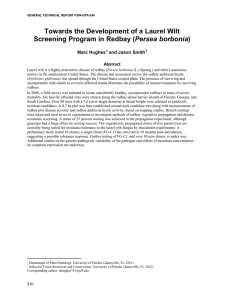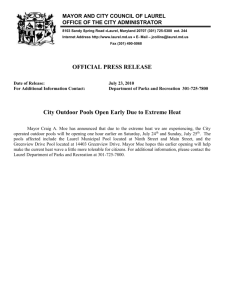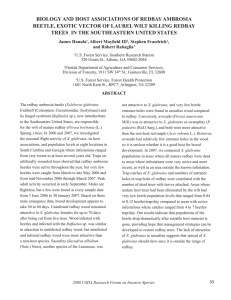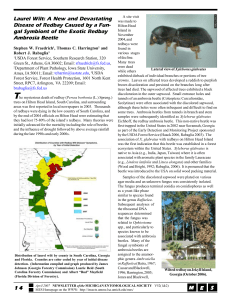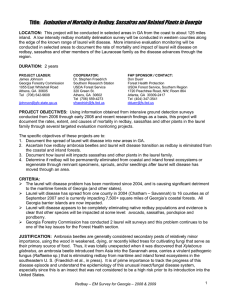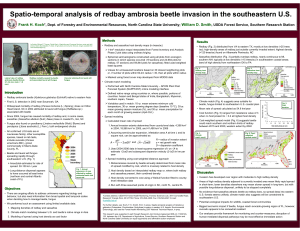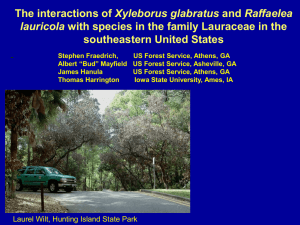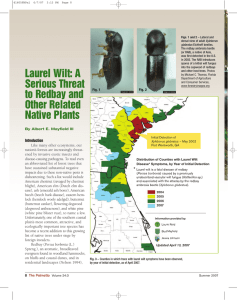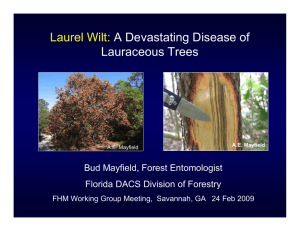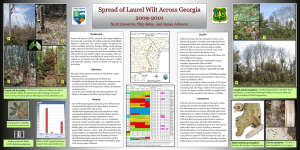Laurel Wilt Disease In Georgia 2006 -
advertisement
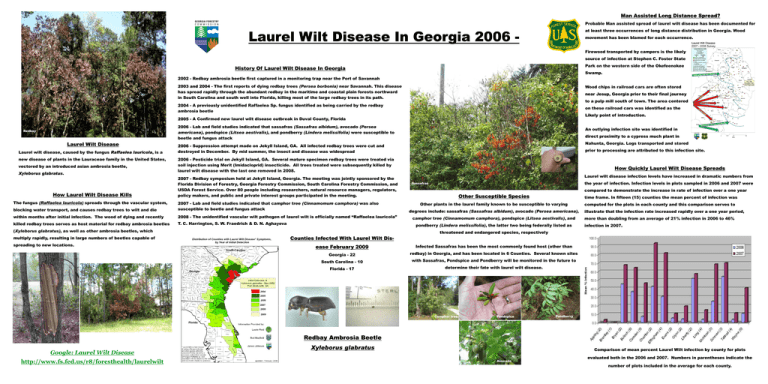
Man Assisted Long Distance Spread? Probable Man assisted spread of laurel wilt disease has been documented for Laurel Wilt Disease In Georgia 2006 - at least three occurrences of long distance distribution in Georgia. Wood movement has been blamed for each occurrence. Firewood transported by campers is the likely source of infection at Stephen C. Foster State Park on the western side of the Okefeenokee History Of Laurel Wilt Disease In Georgia Swamp. 2002 - Redbay ambrosia beetle first captured in a monitoring trap near the Port of Savannah 2003 and 2004 - The first reports of dying redbay trees (Persea borbonia) near Savannah. This disease has spread rapidly through the abundant redbay in the maritime and coastal plain forests northward in South Carolina and south well into Florida, killing most of the large redbay trees in its path. Wood chips in railroad cars are often stored near Jesup, Georgia prior to their final journey to a pulp mill south of town. The area centered 2004 - A previously unidentified Raffaelea Sp. fungus identified as being carried by the redbay ambrosia beetle on these railroad cars was identified as the Likely point of introduction. 2005 - A Confirmed new laurel wilt disease outbreak in Duval County, Florida Redbay Laurel Wilt Disease Laurel wilt disease, caused by the fungus Raffaelea lauricola, is a new disease of plants in the Lauraceae family in the United States, vectored by an introduced asian ambrosia beetle, Xyleborus glabratus. How Laurel Wilt Disease Kills The fungus (Raffaelea lauricola) spreads through the vascular system, 2006 - Lab and field studies indicated that sassafras (Sassafras albidum), avocado (Persea americana), pondspice (Litsea aestivalis), and pondberry (Lindera melissifolia) were susceptible to beetle and fungus attack Nahunta, Georgia. Logs transported and stored prior to processing are attributed to this infection site. 2006 - Pesticide trial on Jekyll Island, GA. Several mature specimen redbay trees were treated via soil injection using Merit (Imidacloprid) insecticide. All trees treated were subsequently killed by laurel wilt disease with the last one removed in 2008. 2007 - Redbay symposium held at Jekyll Island, Georgia. The meeting was jointly sponsored by the Florida Division of Forestry, Georgia Forestry Commission, South Carolina Forestry Commission, and USDA Forest Service. Over 80 people including researchers, natural resource managers, regulators, policy makers, and public and private interest groups participated in the meeting. blocking water transport, and causes redbay trees to wilt and die within months after initial infection. The wood of dying and recently 2008 - The unidentified vascular wilt pathogen of laurel wilt is officially named “Raffaelea lauricola” killed redbay trees serves as host material for redbay ambrosia beetles T. C. Harrington, S. W. Fraedrich & D. N. Aghayeva How Quickly Laurel Wilt Disease Spreads Laurel wilt disease infection levels have increased in dramatic numbers from the year of infection. Infection levels in plots sampled in 2006 and 2007 were Sassafras compared to demonstrate the increase in rate of infection over a one year Other Susceptible Species time frame. In fifteen (15) counties the mean percent of infection was Other plants in the laurel family known to be susceptible to varying degrees include: sassafras (Sassafras albidum), avocado (Persea americana), camphor tree (Cinnamomum camphora), pondspice (Litsea aestivalis), and pondberry (Lindera melissifolia), the latter two being federally listed as (Xyleborus glabratus), as well as other ambrosia beetles, which spreading to new locations. direct proximity to a cypress much plant in 2006 - Suppression attempt made on Jekyll Island, GA. All infected redbay trees were cut and destroyed in December. By mid summer, the insect and disease was widespread 2007 - Lab and field studies indicated that camphor tree (Cinnamomum camphora) was also susceptible to beetle and fungus attack multiply rapidly, resulting in large numbers of beetles capable of An outlying infection site was identified in Counties Infected With Laurel Wilt Dis- computed for the plots in each county and this comparison serves to illustrate that the infection rate increased rapidly over a one year period, more than doubling from an average of 21% infection in 2006 to 46% infection in 2007. threatened and endangered species, respectively ease February 2009 Infected Sassafras has been the most commonly found host (other than Georgia - 22 redbay) in Georgia, and has been located in 6 Counties. Several known sites South Carolina - 10 with Sassafras, Pondspice and Pondberry will be monitored in the future to Florida - 17 determine their fate with laurel wilt disease. Camphor tree Pondspice Pondberry Redbay Ambrosia Beetle Google: Laurel Wilt Disease http://www.fs.fed.us/r8/foresthealth/laurelwilt Xyleborus glabratus Comparison of mean percent Laurel Wilt infection by county for plots Avocado evaluated both in the 2006 and 2007. Numbers in parentheses indicate the number of plots included in the average for each county.
